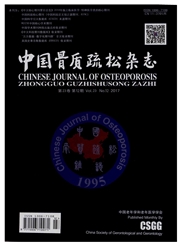

 中文摘要:
中文摘要:
目的探讨在衰老过程中骨组织的端粒酶逆转录酶(telomerase reverse transcriptase,TERT)及其相关因子随增龄的变化情况。方法 6月龄、10月龄、13月龄、18月龄SD大鼠各20只(雌雄各半),取左侧完整股骨按组别、性别排列整齐,Discovery Wi双能X线骨密度仪测定股骨BMD,采用东芝800MA平板DR摄片机进行X线摄片。取大鼠右侧股骨近端骨组织行HE染色及图像分析。采用酶联免疫吸附法(ELISA)检测血清中的骨钙素(osteocalcin,BGP)、抗酒石酸酸性磷酸酶5b(tartrateresistant acid phosphatse 5b TRACP5b)、雌二醇(estradiol,E2)、睾酮(testosterone,T)含量。采用实时荧光定量SYBR GREEN法检测第1腰椎中TERT、雌激素受体α(estrogen receptorα,ERα)、mRNA表达。采用Western Blot检测第2腰椎TERT、ERα蛋白的表达。结果 ELISA法检测结果显示大鼠血清中BGP、E2、T水平均随着月龄增大逐渐降低,TRACP5b水平均随着月龄增大逐渐升高(P〈0.05);骨组织中ERα、TERT的mRNA与蛋白表达均随月龄的增长而降低,各组间比较有显著性差异(P〈0.05)。骨密度检测结果显示:雌性大鼠股骨BMD随着月龄增大呈下降态势,且除6月龄外其他月龄雌性均低于同期雄性组(P〈0.05)。雄性BMD均值随着月龄增大呈下降态势,但6月龄与10月龄相比、13月龄与18月龄相比无统计学意义(P〉0.05)。HE染色结果显示6月龄组股骨头骨小梁宽厚且量多稠密,分布均匀,排列规则,相互之间连成网状,未见有骨小梁中断;10月龄之后,骨小梁相对细小,小梁间距较宽,但排列整齐,且雌性较雄性更为明显,13月龄及18月龄组随着月龄增大骨小梁更加纤细,分布稀疏散乱,骨小梁中断多见,小梁间距增大,甚至出现典型骨质疏松松质骨的病理形态改变,且雌性较雄性更为明显。结论大鼠在增龄过程中,体内性激素水平下降的同时,骨组织内TERT转录水平降低,端粒酶活性?
 英文摘要:
英文摘要:
Objective To explorethechangeof telomerasereversetranscriptase( TERT) expression and related factors in theboneduring natural aging process. Methods SD rats of 6 months,7 months,10 months,and 15 months of age,each 20 with 10 males and 10 females,wereselected. Thewholeleft femurs werecollected and arranged in neat rows by group and gender. X-ray films wereperformed using Toshiba 800 MA flat-panel DR radiography machine. Bonemineral density( BMD) was measured using dual-energy X-ray absorptiometry( DXA). Theright proximal femurs werestained using HE method and theimages wereanalyzed.Serum osteocalcin( BGP),tartrate-resistant acid phosphatase5b( TRACP5b),estradiol( E2),and testosterone( T) wereexamineusing enzyme-linked immunosorbent assay. ThemRNA expression of TERT and estrogen receptor α( ERα) in L1 was detected using SYBR GREEN real timequantitativeassay. Theexpression of TERT and ERα protein was detected using Western blotting.Results BGP,E2,and T levels in rats serum gradually decreased with thegrowth of age,but TRACP5 b increased gradually with age( P〈0. 05). ERα and TERT mRNA and protein expression in thebonetissuereduced with agegrowth( P〈0. 05). TheBMD in femalerats decreased significantly with aging,and it was lower than that in malerats a sameageexcept in 6- month rats( P〈0. 05). BMD in malerats showed a trend of declinewith aging,but therewas no differencebetween 6- and 10- month rats,and between 13- and 18-month rats( P〉0. 05). In HE staining,bonetrabecular in thefemurs of 6- month rats was thick and dense,uniformly distributed,regularly arranged,and mutually linked. Therewas no trabecular disconnection. In 10- month rats,thetrabecular bonewas relatively small,trabecular spacing was wide,but it was arranged in rows,and it was moresignificant in females than in males. In 13-month and 18-month rats,thetrabecular bonewas moreslender and sparsely scattered distribution. Thetrabecular bonedisruption was seen moreoften,thetrabecular spaceincreased,a
 同期刊论文项目
同期刊论文项目
 同项目期刊论文
同项目期刊论文
 期刊信息
期刊信息
